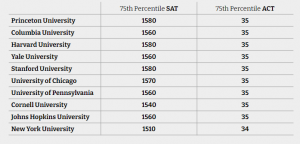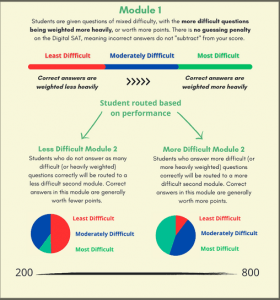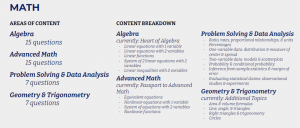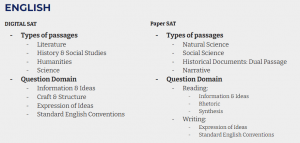
The Digital SAT: Your Master Plan for Success
The Digital SAT: Your Master Plan for Success
In December of 2023, MEK hosted a series of Parent Seminars about the upcoming Digital SAT.
This transition to digital is a major change for the historically paperbased exam, and with that change comes many questions about scoring, test structure, and preparation.
We want you to show up to exam day ready to crush the test and reach your goals. Read on to learn everything you need to know to be prepared for the Digital SAT!
1. What score do you want?
The score you should aim for depends on the schools to which you are applying.
First, ask yourself, “What is my first choice, dream college?”
Then, it’s time to do a little research. You should aim to score in your dream college’s 75th percentile.
Below is a list of the top colleges and universities and the score of their 75th percentile.
You’ll notice that each of the top colleges and universities has a 75th percentile score above 1500. Some of these schools are test optional, so if you are scoring lower than 1500, you might be wondering if it’s even worth taking the SAT?
2. Why take the SAT?
In the last few years, college admissions has become even more competitive, thus making it essential that students do what they can to set themselves apart from their peers.
While top grades and extracurricular activities are essential components of every academic resume, it’s a top SAT score that stands out to admissions officers in addition to how you’ve spent your high school career. Top SAT scores show admissions officers your critical thinking skills as well as your ability to perservere in challenging circumstances.
3. The Digital SAT: What’s changing?
There are a few changes being made to the structure and content of the SAT.
Timing
The Digital SAT will be shorter in length (2 hours & 45 minutes vs. 3 hours & 15 minutes) with a 10 minute break between the Reading/Writing & Math Sections.
Below is a chart breaking down the differences between the Paperbased SAT, the Digital SAT, and the ACT sections.
Grading
The grading scale for the Digital SAT will remain a composite 1600, scored on an 800 scale for both the Reading/Writing and Math sections. There is no penalty for wrong answers or guessing. SuperScores can combine sections from the current paperbased SAT and the Digital SAT.
Structural Changes
The Digital SAT will use multistage adaptive technology. This means that each of the two subjects (Reading/Writing & Math) are divided into two modules. Performance in first module will dictate the difficulty of the second module.
Please note that an easier second module results in a capped score, and the maximum score for the section will no longer be 800.
What does this mean for you? It means accuracy is key.
Check out the image below to learn more about each of the modules and how the multistage adaptive technology works.
Content Changes: Math
On the Digital SAT, you can expect to see a change in the content breakdown as outlined by the image below.
Along with changes to the content, students will be allowed to use a calculator throughout both modules of the Math section. The calculator will be built into the testing platform.
There will also be a change to the amount of Free Response Questions. Students will get 10-12 student-produced response questions out of a total 44 questions. Also, the Free Response Question text box will be non-restrictive, making the domain of possible answers much more open.
Content Changes: English
The following changes will made on the Digital SAT English section:
- The Reading & Writing are combined versus Reading & Writing being two separate sections.
- The questions are randomized.
- Passage length ranges from 25 to 150 words, with one question per passage versus 750 words per passage, with 5 passages per section and 9-10 questions per passage.
- Reading questions include more vocabulary-centric questions, with questions that resemble a sentence completion structure versus all Reading questions being about the passage, and Word in Context questions strictly based on what is given in the passage.
Below is a comparison of the different types of passages you will find on the Digital SAT versus the current SAT.
And be on the lookout for these specific types of passages:
- Reading charts & graphs
- Poetry
- Sentence completions
- Bulleted lists & research findings
- Short dual passages
4. What should I consider when beginning my Digital SAT Prep journey?
There are a few questions you want to ask yourself before you embark on your SAT journey, so you can make the most of your time and reach your goals with ease.
- Where is my current skill level?
- What are my college goals?
- Do I NEED an SAT/ACT score?
- Do I have time and energy to dedicate to test prep?
- By when do I want to be done with the SAT/ACT?
By considering these questions, you’ll not only put yourself in the right mindset for prep, but you’ll be able to construct a prep plan based on your answers.
5. Who should NOT take the Digital SAT?
Postponing taking the SAT or considering alternative College Admissions Test options like the ACT are a good choice for some students. But who should NOT take the SAT?
Students Currently Struggling in School
When looking into SAT Prep, it’s important to consider how you are currently performing in your classes. Are your grades high or low? Are you struggling to keep up with the content of your classes? How are your grades on tests and assignments?
If you answered yes to any of these questions, then you should probably postpone taking the SAT or beginning SAT Prep. We advise that students currently struggling in school dedicate all of their time and energy to improving their class grades before splitting their time between school and test prep.
Remember, a high GPA and top course grades are equally as important as a good SAT score to college admissions officers.
Students with Minimal Time to Commit to Test Prep
Preparing for the SAT takes dedication, hard work, and sacrifice. On average, students preparing for the SAT should be dedicating 8 hours a week to test prep. This time includes attending SAT Prep courses, taking practice exams, and studying outside of class.
Students engaging in extracurricular activities, working after school, or struggling with time management need to think about whether SAT Prep fits into their current schedule as this is a daily commitment.
Next Steps
Interested in SAT Prep?
For students interested in SAT Prep, take a Digital SAT with MEK! You’ll receive a free consultation with an expert counselor, course recommendations based on your Digital SAT practice test score, and a customized test prep plan to help you reach your goals. Click here to sign up for a Digital SAT Practice Test to get started!
Interested in alternatives to SAT Prep?
For students looking for alternatives to the SAT, the ACT is also a good option. For more information, check out our resources to learn all about the ACT, including differences between the SAT and ACT and who is a good fit for the test.
ACT Resources
ACT Exam Guide: All About the ACT
SAT vs. ACT: Which One Should You Take?
MEK offers ACT Connect, our self-paced, virtual lecture based series, where YOU set the schedule for your test prep experience. Click here to learn more about ACT Connect!
We look forward to helping you along your journey to academic and admissions success!








